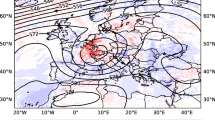Abstract
The concept of employing synthetic storm data to evaluate simpler attenuation prediction techniques based on cumulative distributions of point rain rate is introduced. As examples, several versions of the «path average rain rate technique» and a new method developed by Crane are tested using 10-year rain rate data bases from several Canadian locations. The results indicate that there is no universal relationship for the ratio of the path average to the point rain rate in terms of either rain rate or percentage of time. However, Crane’s new method appears to be an improvement over earlier versions of the path average rain rate technique.
Analyse
Le présent article concerne l’emploi d’une conversion des intensités de précipitation mesurées localement en répartition le long d’un trajet pour évaluer des techniques plus simples de prévision des affaiblissements, lesquelles se fondent sur la distribution cumulative de l’intensité des précipitations locales. Utilisant les intensités des précipitations enregistrées sur une période de dix ans à divers endroits au Canada, on a expérimenté, à titre d’exemples, quelques variantes de la technique de distribution de l’intensité moyenne des précipitations le long d’un trajet et une nouvelle méthode mise au point par Crane. Les résultats obtenus indiquent qu’il n’existe pas de relation universelle entre la valeur moyenne de l’intensité de précipitation le long d’un trajet et sa valeur en un point en fonction de l’intensité de précipitation ou du pourcentage de temps. Toutefois, la méthode mise au point par Crane semble supérieure aux précédentes.
Similar content being viewed by others
References
Barsis (A. P., Samson (C. A.. Performance estimation for 15 GHz microwave links as a function of rain attenuation.IEEE Trans. COM, USA (Apr. 1976),24, n∘ 4, pp. 462–470.
Crane (R. K.). A global model for rain attenuation prediction.IEEE Eastcon Record, USA (1978), pp. 391–395.
Harden (B. N., Norbury (J. R., White (W. J. K.. Estimation of attenuation by rain on terrestrial radio links in the UK at frequencies from 10 to 100 GHz.IEE J. Microwave, Opt. and Acoust., GB (July 1978),2, n∘ 4, pp. 97–104.
Mogensen (G.), Stephansen (E.). An estimation of methods for prediction of rain induced attenuation on los paths.iee Conf. Proc., London (1978), n∘ 169, part 2, pp. 97–101.
Watson (P. A.), Ahmed (H. J.), Papaioannou (G.). Long term prediction of attenuation on terrestrial radio links from rainfall data.IEE Conf. Proc., London (1978), n∘ 169, part 2, pp. 92–96.
Crane (R. K.. Prediction of attenuation by rain.IEEE, Trans. COM., USA (1980),28, n∘ 9, pp. 1717–1733.
Drufuca (G.. Rain attenuation statistics for frequencies above 10 GHz from raingauges observations.J. Rech. atmosph., Fr. (1974),8, n∘ 1-2, pp. 399–412.
Drufuca (G.. Rain attenuation studies. Stormy Weather Group Scientific Report MW-77,McGill Univ., Montreal (1973).
Bertok (E.), DeRenzis (G.), Drufuca (G.). Estimate of attenuation due to rain at 11 GHz from raingauge data. Proc. ofURSI Commission F Open Symposium,CNET, Issy-les-Moulineaux, Fr. (1977), pp. 295–300.
Drufuca (G., Rogers (R. R.. Statistics of rainfall over paths from 1 to 50 km.Atmosph. Environ., GB (1978),12, pp. 2333–2342.
CCIR Report 233-3. Influence of the non-ionized atmosphere on wave propagation. Ground-ground propagation.IUT, Geneva (1975), V, pp. 66–79.
Olsen (R. L., Rogers (D. V., Hodge (D. B.. The aRb relation in the calculation of rain attenuation.IEEE Trans. AP, USA (Mar. 1978),26, n∘ 2, pp. 318–329.
Nowland (W. L., Olsen (R. L., Shkarofsky (I. P.. Theoretical relationship between rain depolarisation and attenuation.Electron. Letters, GB (Oct. 1977),13, n∘ 22, pp. 676–678.
Kheirallah (H. N., Knight (J. P., Olsen (R. L., McCormick (K. S., Segal (B.. Frequency dependence of effective path length in the prediction of rain attenuation statistics.Electron. Letters GB (Jun. 1980),16, n∘ 12, pp. 448 450.
Segal (B.. High-intensity rainfall statistics for Canada. CRC Report 1329-E,Communic. Res. Centre, Ottawa (1979).
Segal (B.. A new procedure for the determination and classification of rainfall rate climatic zones.Ann. Telecommunic., Fr. (1980),35, n∘ 11-12, pp. 411–417.
Jones (D. M. A., Sims (A. L.. Climatology of instantaneous precipitation rates. Report AFCRL-TR-783-0171 (prepared by the Illinois State Water Survey),Rome Air Development Center, Bedford, USA (1971).
Damosso (E., DeRenzis (G., Fedi (F., Migliorini (P.. A systematic comparison of rain attenuation prediction methods for terrestrial paths.Ann. Telecommunic., Fr. (1980),35, n∘ 11-12, pp. 463–469.
Author information
Authors and Affiliations
Additional information
Formerly with Department of Electronics, Carleton University, Ottawa, Canada K1S 5B6.
Rights and permissions
About this article
Cite this article
Kheirallah, H.N., Segal, B. & Olsen, R.L. Application of synthetic storm data to evaluate simpler techniques for predicting rain attenuation statistics. Ann. Télécommunic. 35, 456–462 (1980). https://doi.org/10.1007/BF03003528
Received:
Issue Date:
DOI: https://doi.org/10.1007/BF03003528




